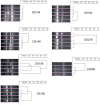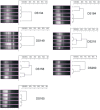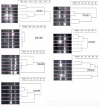Molecular variations in Vibrio alginolyticus and V. harveyi in shrimp-farming systems upon stress
- PMID: 26691457
- PMCID: PMC4704611
- DOI: 10.1590/S1517-838246420140410
Molecular variations in Vibrio alginolyticus and V. harveyi in shrimp-farming systems upon stress
Abstract
A study was performed to investigate the genomic variations in the shrimp farm isolates of Vibrio alginolyticus and V. harveyi when the isolates were subjected to environmental stress. Samples of shrimps, water and sediment were collected from Southern Indian coastal shrimp farms. Vibrio isolates were biochemically identified and confirmed using 16S rDNA and gyrB gene specific PCR. The bacterial strains were genotyped by PCR fingerprinting using GTG(5) and IS (Insertion Sequence) primers. Seven strains each of V. alginolyticus and V. harveyi were subjected to 10 passages through trypticase soya broth (TSB), which contained different NaCl concentrations (3, 6 and 8%) and trypticase soya agar (TSA). V. alginolyticus was also passaged through TSB with a 12% NaCl concentration. PCR fingerprinting, which was performed on the strains that were passaged through different salt concentrations, confirmed that V. alginolyticus and V. harveyi could affect the genomic variations, depending on the environmental conditions of the culture. The study highlights the complex genotypic variations that occur in Vibrio strains of tropical aquatic environment because of varied environmental conditions, which result in genetic divergence and/or probable convergence. Such genetic divergence and/or convergence can lead to the organismal adaptive variation, which results in their ability to cause a productive infection in aquatic organisms or generation of new strains.
Figures





Similar articles
-
Genetic heterogeneity among Vibrio alginolyticus isolated from shrimp farms by PCR fingerprinting.Lett Appl Microbiol. 2005;40(5):369-72. doi: 10.1111/j.1472-765X.2005.01675.x. Lett Appl Microbiol. 2005. PMID: 15836741
-
Molecular characterization of antibiotic resistant Vibrio harveyi isolated from shrimp aquaculture environment in the south east coast of India.Microb Pathog. 2016 Aug;97:110-8. doi: 10.1016/j.micpath.2016.05.021. Epub 2016 May 28. Microb Pathog. 2016. PMID: 27247095
-
Vibrio alginolyticus infection in the white shrimp Litopenaeus vannamei confirmed by polymerase chain reaction and 16S rDNA sequencing.Dis Aquat Organ. 2004 Oct 21;61(1-2):169-74. doi: 10.3354/dao061169. Dis Aquat Organ. 2004. PMID: 15584425
-
Molecular Identification of Vibrio alginolyticus Causing Vibriosis in Shrimp and Its Herbal Remedy.Pol J Microbiol. 2019 Dec;68(4):429-438. doi: 10.33073/pjm-2019-042. Epub 2019 Oct 31. Pol J Microbiol. 2019. PMID: 31880887 Free PMC article.
-
Vibrio alginolyticus gyrB sequence analysis and gyrB-targeted PCR identification in environmental isolates.Dis Aquat Organ. 2008 Dec 22;82(3):209-16. doi: 10.3354/dao01984. Dis Aquat Organ. 2008. PMID: 19244972
Cited by
-
Integrated analysis of intestinal microbiota and metabolomic reveals that decapod iridescent virus 1 (DIV1) infection induces secondary bacterial infection and metabolic reprogramming in Marsupenaeus japonicus.Front Immunol. 2022 Sep 16;13:982717. doi: 10.3389/fimmu.2022.982717. eCollection 2022. Front Immunol. 2022. PMID: 36189245 Free PMC article.
References
-
- Abdallah FB, Kallel H, Bakhrouf A. Enzymatic, outer membrane proteins and plasmid alterations of starved Vibrio parahaemolyticus and Vibrio alginolyticus cells in seawater. Mol Microbiol. 2009;191:493–500. - PubMed
-
- Alsina M, Blanch AR. A set of keys for the biochemical identification of environmental vibrios. J Appl Bacteriol. 1994a;76:79–85. - PubMed
-
- Alsina M, Blanch AR. Improvement and update of a set of keys for biochemical identification of Vibrio species. J Appl Bacteriol. 1994b;77:719–721. - PubMed
-
- Brazil JM, Alves RM, Rivera ING, et al. Prevalence of virulence-associated genes in clinical and environmental Vibrio cholerae strains isolated in Brazil between 1991 and 1999. FEMS Microbiol Lett. 2002;215:15–21. - PubMed
-
- Cano-Gomez A, Bourne DG, Hall MR, et al. Molecular identification, typing and tracking of Vibrio harveyi in aquaculture systems: current methods and future prospects. Aquaculture. 2009;287:1–10.
Publication types
MeSH terms
Substances
LinkOut - more resources
Full Text Sources
Research Materials
